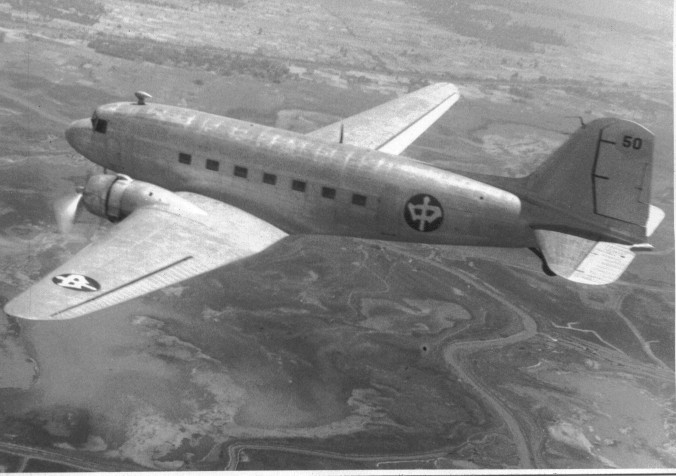Difference between revisions of "Douglas DC-53"
From CNAC
TomHutchison (talk | contribs) m |
TomHutchison (talk | contribs) m |
||
| (One intermediate revision by the same user not shown) | |||
| Line 1: | Line 1: | ||
{{Aircraft | {{Aircraft | ||
|Aircraft Main Image=DC-3-CNAC-TN-50.jpg | |Aircraft Main Image=DC-3-CNAC-TN-50.jpg | ||
| − | |Crew= | + | |Crew=3 |
|Crew Type=pilot, co-pilot | |Crew Type=pilot, co-pilot | ||
| − | |Passenger Capacity= | + | |Passenger Capacity=27 |
| − | + | |Cargo Capactity=12,200 | |
| − | |Cargo Capactity= | + | |Length=63.75 |
| − | |Length= | + | |Wingspan=95.5 |
| − | |Wingspan=95. | + | |Height=17 |
| − | |Height= | + | |Gross Weight=31,000 |
| − | + | |Powerplant=2 × Pratt & Whitney R-1830-92 engines | |
| − | |Gross Weight= | ||
| − | |Powerplant=2 × Pratt & Whitney R-1830- | ||
|Propellers=3-bladed Hamilton Standard 23E50 series, 11 ft 6 in (3.5 m) diameter | |Propellers=3-bladed Hamilton Standard 23E50 series, 11 ft 6 in (3.5 m) diameter | ||
|Max Speed=230 | |Max Speed=230 | ||
| − | |Cruise Speed= | + | |Cruise Speed=160 |
| − | |Range=1, | + | |Range=1,600 |
| − | |Service Ceiling= | + | |Service Ceiling=24,000 |
| − | |Summary=The Douglas DC-3 | + | |Summary=The '''Douglas C-53 Skytrooper''' was a dedicated troop transporter aircraft series developed from the DC-3. It was very similar to the C-47 Skytrain, but it lacked the reinforced cargo floor, large cargo door and hoist attachment of the C-47. As a result the C-53 was much less flexible in operation than the C-47. Only 380 were built by Douglas. |
| − | + | The C-53 is usually referred to as a C-47 when specifications are searched. The following specifications are the best available information that can be found on the C-53/C-47. | |
| + | |||
| + | Accommodation: Three crew and 6,000 pounds of cargo, or 28 airborne troops, or 14 stretcher patients and three attendants.<ref>https://www.boeing.com/history/products/c-47-skytrain.page</ref> | ||
}} | }} | ||
Latest revision as of 15:08, 16 April 2020

|
| Crew: 3 crew members3 person <br /> |
| Crew Type: pilot, co-pilot |
| Passenger Capacity: 27 passengers27 people <br /> |
| Length: 63.75 ft19.431 m <br /> |
| Wingspan: 95.5 ft29.108 m <br /> |
| Height: 17 ft5.182 m <br /> |
| Cargo Capactity 12,200 lbs6.1 tons <br />5,533.822 kg <br /> |
| Gross Weight: 31,000 lbs15.5 tons <br />14,061.352 kg <br /> |
| Powerplant: 2 × Pratt & Whitney R-1830-92 engines |
| Propellers: 3-bladed Hamilton Standard 23E50 series, 11 ft 6 in (3.5 m) diameter |
| Max Speed: 230 mph199.864 kts <br />425.96 km/h <br /> |
| Cruise Speed: 160 mph139.036 kts <br />296.32 km/h <br /> |
| Range: 1,600 miles1,390.362 nm <br />2,963.2 km <br /> |
| Service Ceiling: 24,000 ft7,315.2 m <br /> |
Summary
The Douglas C-53 Skytrooper was a dedicated troop transporter aircraft series developed from the DC-3. It was very similar to the C-47 Skytrain, but it lacked the reinforced cargo floor, large cargo door and hoist attachment of the C-47. As a result the C-53 was much less flexible in operation than the C-47. Only 380 were built by Douglas.
The C-53 is usually referred to as a C-47 when specifications are searched. The following specifications are the best available information that can be found on the C-53/C-47.
Accommodation: Three crew and 6,000 pounds of cargo, or 28 airborne troops, or 14 stretcher patients and three attendants.[1]
CNAC Aircraft Data: Douglas DC-53
Below is all the known data available for this model of this aircraft used by C.N.A.C. They are sorted by: C.N.A.C. Service Start Date, Maker Number, C.N.A.C. Tail Number.
| Tail # | Nickname | Maker # | Service Start | Service End | Crew | End Cause | Notes | Sources |
|---|---|---|---|---|---|---|---|---|
| 48 | 41-20082 | 4852 | 26 February 1942 | 11 August 1943 | Shot down by Japanese | |||
| 49 | 41-20083 | 4853 | 26 February 1942 | 13 March 1943 | Missing | |||
| 51 | 41-20109 | 4879 | 12 May 1942 | 24 March 1944 | Crash | |||
| 52 | 41-20132 | 4902 | 19 May 1942 | 10 October 1942 | Crash | |||
| 53 | 41-20134 | 4904 | 25 May 1942 | 11 March 1943 | Missing | |||
| 54 | 42-06475 | 4927 | 28 May 1942 | 1 December 1949 | To XT-45. To N8361C 12/49 | |||
| 55 | 42-06477 | 4929 | 4 June 1942 | 1 December 1949 | To XT-55. | |||
| 56 | 41-20111 | 4881 | 9 June 1942 | 12 December 1944 | Crash | |||
| 57 | 41-20113 | 4883 | 12 June 1942 | 18 February 1944 | Crash | |||
| 58 | 42-15890 | 7407 | 18 September 1942 | 7 April 1943 | Missing 7.4.43 | |||
| 59 | 42-15889 | 7406 | 7 October 1942 | 19 November 1943 | Crash | |||
| 50 | 41-20101 | 4871 | 4 December 1942 | 1 December 1949 | To XT-90. To N8367C 12/49 | Still extant! |
